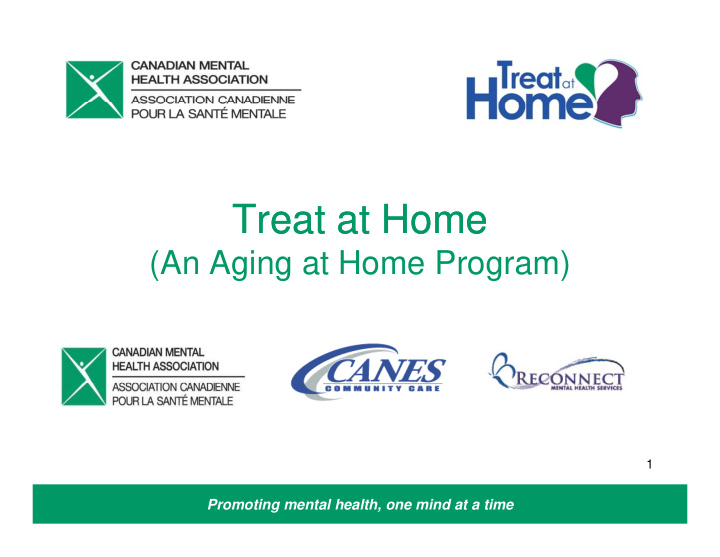



Treat at Home Treat at Home (An Aging at Home Program) 1 Promoting mental health, one mind at a time
Purpose Purpose • To serve seniors in their homes who require assessment, clinical and i t li i l d supportive monitoring, intensive home delivery of mental health and primary care d li f t l h lth d i services in order to prevent unnecessary use of ER and inpatient facilities. f ER d i ti t f iliti 2 Promoting mental health, one mind at a time
Two Foci Two Foci • Service delivery to clients. • Development of a psychogeriatric network. 3 Promoting mental health, one mind at a time
Target Population for Service Target Population for Service 1. Seniors experiencing mental health problems or mental illness mental illness. 2. Individuals with serious mental illness experiencing accelerated aging (55+) Target Population for Network Service providers working with either of the above Service providers working with either of the above populations. 4 Promoting mental health, one mind at a time
Key Learnings Key Learnings • This population is significantly more fragile and complex than originally thought (complex physical health and addictions in originally thought (complex physical health and addictions in addition to mental health). • Caregiver health is often compromised as well. • C Connections to primary care are critical but sometimes not easily ti t i iti l b t ti t il available. • Polypharmacy requiring medication management and support is a significant issue. i ifi t i • Hoarding is a problem for a few clients and uses significant services. 5 Promoting mental health, one mind at a time
Service Delivery Service Delivery Program achievements • 84 clients served (November to March 31) (prorated target of 55) • By end of first quarter 2011: f f - 78 clients served (ahead of target). • 30+ ER visits hospitalizations prior to TAH; • 30+ ER visits hospitalizations prior to TAH; decreased to 5. 6 Promoting mental health, one mind at a time
Implementation Process Implementation Process • Deciding to Partner analysis completed by Senior Management. • • Operations and Senior Management team meetings established Operations and Senior Management team meetings established. • Developed an MOU (organizational) and a service agreement (operational) • Developed a Terms of Reference for the psychogeriatric network Developed a Terms of Reference for the psychogeriatric network. 7 Promoting mental health, one mind at a time
Challenges Ch ll • Ongoing recruitment and issues Community Support Sector and Mental Health Sector track visits differently. • Definition of visits are constantly changing – a work in progress at provincial level. • B Brokerage case management versus intensive case management. k t i t i t • Highly complex clients with often few appropriate or receptive referral sources. 8 Promoting mental health, one mind at a time
Effectiveness Effectiveness • Exceeding range of revised target number of clients seen. • Established benchmarks for face to face visits • Cost per unit of service $212.00 - benchmarks as per Health Care Indicator Tool (HIT): benchmarks as per Health Care Indicator Tool (HIT): $58.93 to $155.47 • Cost per client $1,622.00 p , - benchmarks as per HIT: $2,838.52 to $4,531.82 • 4% administrative costs budgeted. 9 Promoting mental health, one mind at a time
Client Feedback Client Feedback 1. 90% agreed the worker respected their rights. 2 2. 84% 84% agreed got the services they thought they d t th i th th ht th needed. 3. 3. 79% agreed they were able to see a worker when they 79% agreed they were able to see a worker when they needed to. 4. 69% agreed their mental health and physical health needs were met (lack of awareness re mental health). d t (l k f t l h lth) 5. 59% agreed their worker connected them to other programs and services. programs and services. 10 Promoting mental health, one mind at a time
Critical Success Factors Critical Success Factors • Established common benchmarks • Strong infrastructure to ensure clinical soundness g • Client was central to all agencies • An effort made to always have decision makers for all agencies present present • Ongoing communication for clarity at all levels • Recently ensured front line staff meet regularly as an “intake team”. • R Revisit mandate as required. i it d t i d • Involvement of Sheridan Elder Research Centre and survey of caregivers. 11 Promoting mental health, one mind at a time
Linkages and Partnerships g p • CMHA/Peel • CANES • Malton Neighbourhood Services • Reconnect • Headwaters Health Centre • William Osler Psychogeriatic Team • Peel Regional Police g • Members of the Psychogeriatic Network • Service Canada • Wise Elephant Health Team • India Rainbow • Caledon Community Service • WOHC • CW- CCAC • PAARC • St. Elizabeth Peel Crisis Services • P Peel Senior Link l S i Li k • Richview Residence • CAMH • Peel Elder Abuse Prevention Network • Rexdale CHC • Trellis Health Care • Spectra Support Services 12 Promoting mental health, one mind at a time
Development of the Central West Development of the Central West Psychogeriatric Network • 21 members from multiple sectors. 21 b f lti l t • Terms of Reference completed. • Sheridan Elder Research Center enhancing the Aging • Sheridan Elder Research Center enhancing the Aging Mental Health and Addictions Tool Kit as an educational tool for all network providers. 13 Promoting mental health, one mind at a time
Recommend
More recommend